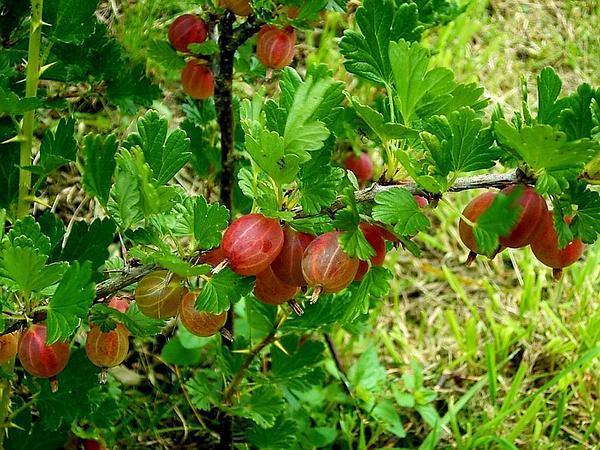Look around any yard in the United States and you're bound to see a limited palette of ornamental shrubs used as foundation plantings, hedges, and specimen plantings. Although beautiful, I can't help but think they're missing out on a great opportunity to grow similarly attractive shrubs that are edible instead.

The first order of business is to decide which shrubs to grow. Much of your decision will be determined by usage and site exposure. Do you need shrubs as foundation plantings around the house, a screen to block a utility box, or a barrier to the neighbor's yard? Does the site get full sun, is it exposed to cold winter winds, or does it have poor soil? Selecting the right shrub for the usage is key. Some shrubs make great foundation plantings, while others will sprawl and spread and are better as informal hedges. A common sight is an overgrown yew or juniper almost blocking a window because it was the wrong shrub for that location. Look at the shrub's ultimate height, width, hardiness zone and sun requirements before deciding to plant. As with any ornamental planting, determine if flowering and foliage color and texture will work in that location.
Once you decide the function of the shrub and the likely location to plant it, then the fun begins. Selecting edible shrubs to plant instead of the usual ornamental shrubs gives you the opportunity to produce some tasty food for your family, as well as have an attractive yard.
While it's great to plant all edibles in your yard, there's no problem with mixing in a blueberry here or a currant there with other ornamental plantings. As long as the growing requirements are met, feel free to experiment. Some gardeners like to mix in evergreens, such as arborvitae, with deciduous fruit plantings to add greenery for winter.
Here are some edible shrubs to grow based on their function in the landscape.
Edible Shrubs as Foundation Plantings
Foundation plantings are those shrubs planted immediately around your home. The most important aspect to these shrubs is selecting ones that grow in the space allotted without requiring drastic pruning. Also, areas next to the home, especially those with a southern exposure, can be excessively hot. Select plants that can take these conditions.
Some good foundation plantings to try include blueberry, currant, gooseberry, natal plum, rosemary, and bush plums.
Edible Shrubs as Hedges
Hedges are great for defining gardens and creating "rooms". Taller hedges can create the sense of privacy, while low growing hedges help border a garden space. Hedges can be trimmed into a formal shape, like a boxwood hedge, or left to grow to their natural size, like a lilac hedge. Hedge plants can be grown individually to block unsightly objects in the yard, such as utility boxes.
Some good shrubs to grow as hedges include blueberry, bush plum, currant, gooseberry, hazelbert, natal plum, American cranberry bush, and pineapple guava.
Edible Shrubs as Barriers
Sometimes you need your hedges to be formidable enough to keep wildlife and humans out. There are some edible shrubs that can be grown as barriers to create a natural fence. These have thorns to thwart even the most determined trespasser. Some good edible shrubs to grow as a barrier include brambles, gooseberry, natal plum, and Rugosa rose.
Edible Shrub Descriptions
All shrubs below are deciduous and grow best in full sun and on well-drained soil unless otherwise stated.
 Charlie Nardozzi is an award winning, nationally recognized garden writer, speaker, radio, and television personality. He has worked for more than 30 years bringing expert gardening information to home gardeners through radio, television, talks, tours, on-line, and the printed page. Charlie delights in making gardening information simple, easy, fun and accessible to everyone. He's the author of 6 books, has three radio shows in New England and a TV show. He leads Garden Tours around the world and consults with organizations and companies about gardening programs. See more about him at Gardening With Charlie.
Charlie Nardozzi is an award winning, nationally recognized garden writer, speaker, radio, and television personality. He has worked for more than 30 years bringing expert gardening information to home gardeners through radio, television, talks, tours, on-line, and the printed page. Charlie delights in making gardening information simple, easy, fun and accessible to everyone. He's the author of 6 books, has three radio shows in New England and a TV show. He leads Garden Tours around the world and consults with organizations and companies about gardening programs. See more about him at Gardening With Charlie.
 Victory Seed Company has all the seeds you want for your best garden in 2024.
Victory Seed Company has all the seeds you want for your best garden in 2024.
For 25 years, the family-owned Victory Seed Company has provided the highest quality vegetable, herb and flower seeds to families across the country. We are passionate about providing you the best seeds available that give excellent germination, robust plants, and the harvest you want. With a catalog of over a thousand varieties, we have everything, and our prices are the kinds that we'd want to pay. We have hundreds of yesterday's heirloom vegetables, as well as today's award winning hybrid selections. Get to know us by visiting our website and browsing through our online vegetable seed catalog.